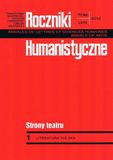Franciszka Siedleckiego droga do teatru
Franciszek Siedlecki's Way to the Theatre
Author(s): Ewa Zatorska-SalmanowiczSubject(s): Literary Texts
Published by: Towarzystwo Naukowe KUL & Katolicki Uniwersytet Lubelski Jana Pawła II
Keywords: Franciszek Siedlecki's biographical entry; Franciszek and Jadwiga Siedlecki's correspondence; calendar of exhibitions; biogram Franciszka Siedleckiego; korespondencja Franciszka i Jadwigi Siedleckich; kalendarium wystaw
Summary/Abstract: Franciszek Wincenty Siedlecki was born in Krakow on 23rd July 1867. He was a graphic artist, painter, stage designer, and theatre critic. After his graduation from a secondary school, he became a law student at the Jagiellonian University. He also studied painting at the Academy of Arts in Munich and Academie Colarossi in Paris. Siedlecki met the theatre for the first time in his hometown Krakow. The year 1908 saw his debut as a decorator in the Town Theatre; he worked no Norwid’s Krakus together with Józef Sosnowski. In the following artistic season he made the stage design projects to the Balladyna, Lilla Weneda, and Sen srebrny Salomei. In 1909 the director of the Great Theatre in Warsaw offered him a job of decorator, and he accepted the offer. He designed costumes for the Summer Night Dream. Two years later he was made head of the decorative department a the Unified Theatre. He made interesting decorations to Wesele, Taming of the Shrew, and Irydion. He was also famous for being a co-organiser of the Exhibition of Modern Scenic Painting. In the years of 1914-1919 he was in Switzerland, where he made penetrating analyses of Rudolf Steiner’s anthroposophy, and designed stained-glass for Goetheanum. The final fourteen years of his life were devoted exclusively to painting and writing. In the years of 1921-1930 he collaborated with Warsaw journals as a theatrical reviewer. He published his reviews, sketches, and studies in “Sztuka i życie,” “Dzień Polski,” “Południe,”, “Sztuka i Praca,” “Muzyka,” “Rzeczpospolita,” “Życie i Teatr,” “Gazeta Administracji i Policji Państwowej,” and “Scena Polska.” He also participated in many international exhibitions, where he presented his oil paintings, drawings, prints, and water paintings. Having lived 67 years as an artist, he died after a long illness on 1st October 1934 in Warsaw.
Journal: Roczniki Humanistyczne
- Issue Year: 58/2010
- Issue No: 01
- Page Range: 11-36
- Page Count: 26
- Language: Polish

